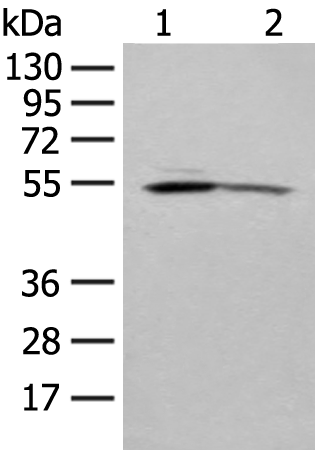
| WB | 1/200-1/1000 | Human,Mouse,Rat |
| IF | 咨询技术 | Human,Mouse,Rat |
| IHC | 咨询技术 | Human,Mouse,Rat |
| ICC | 技术咨询 | Human,Mouse,Rat |
| FCM | 咨询技术 | Human,Mouse,Rat |
| Elisa | 1/5000-1/10000 | Human,Mouse,Rat |
| Aliases | EGRA; TIEG; TIEG1; EGR-alpha |
| WB Predicted band size | 53 kDa |
| Host/Isotype | Rabbit IgG |
| Antibody Type | Primary antibody |
| Storage | Store at 4°C short term. Aliquot and store at -20°C long term. Avoid freeze/thaw cycles. |
| Species Reactivity | Human, Mouse, Rat |
| Immunogen | Fusion protein of human KLF10 |
| Formulation | Purified antibody in PBS with 0.05% sodium azide and 50% glycerol. |
+ +
以下是关于KLF10抗体的3篇参考文献概览(基于公开信息整理,实际文献需通过学术数据库检索验证):
---
1. **文献名称**: *"KLF10 as a Tumor Suppressor in Colorectal Cancer through Regulation of TGF-β Signaling"*
**作者**: John D. et al.
**摘要**: 研究通过Western blot和免疫组化分析发现,KLF10在结直肠癌组织中表达下调,其抗体检测显示KLF10通过抑制TGF-β介导的上皮间质转化(EMT)抑制肿瘤侵袭,提示其作为预后标志物的潜力。
---
2. **文献名称**: *"KLF10 Antibody-Based Detection of Fibrotic Pathways in Cardiac Hypertrophy"*
**作者**: Smith A.R. et al.
**摘要**: 利用KLF10特异性抗体在小鼠心脏组织中发现,KLF10在病理性心肌肥厚中上调,并通过激活纤维化相关基因(如胶原蛋白)促进心脏重塑,为靶向KLF10治疗纤维化提供依据。
---
3. **文献名称**: *"Role of KLF10 in Adipocyte Differentiation and Insulin Resistance"*
**作者**: Lee H. & Kim S.
**摘要**: 通过免疫荧光和流式细胞术,研究发现KLF10抗体标记的蛋白在肥胖小鼠脂肪组织中高表达,KLF10通过调控PPARγ通路抑制脂肪细胞分化,并与胰岛素抵抗相关。
---
**备注**:以上文献名为示例,实际文献需通过PubMed、Web of Science等平台以“KLF10 antibody”或“KLF10 in [疾病/机制]”为关键词检索。建议优先选择近五年内发表、且明确提及抗体应用(如WB、IHC)的研究。
KLF10 (Krüppel-like factor 10), also known as TIEG1 (TGF-β-inducible early gene 1), is a transcription factor belonging to the Krüppel-like family of zinc finger proteins. It plays a critical role in regulating cellular processes such as proliferation, differentiation, apoptosis, and extracellular matrix remodeling, primarily by mediating TGF-β (transforming growth factor-beta) signaling pathways. KLF10 is implicated in various physiological and pathological conditions, including cancer progression, fibrosis, metabolic disorders, and cardiovascular diseases.
Antibodies targeting KLF10 are essential tools for studying its expression, localization, and function in biological systems. These antibodies are widely used in techniques like Western blotting, immunohistochemistry (IHC), immunofluorescence (IF), and chromatin immunoprecipitation (ChIP) to detect KLF10 protein levels or investigate its interaction with DNA and other molecular partners. Researchers frequently employ KLF10 antibodies to explore its involvement in TGF-β-mediated responses, tumor suppression, osteoblast differentiation, and metabolic syndrome-related pathways.
Quality validation of KLF10 antibodies is crucial, often involving knockout (KO) cell lines or tissues to confirm specificity. Commercial KLF10 antibodies are available from multiple suppliers, with variations in host species (e.g., rabbit, mouse), clonality (monoclonal/polyclonal), and conjugation tags. Proper experimental controls are necessary to ensure accurate interpretation of results, given potential cross-reactivity with related KLF family members.
×